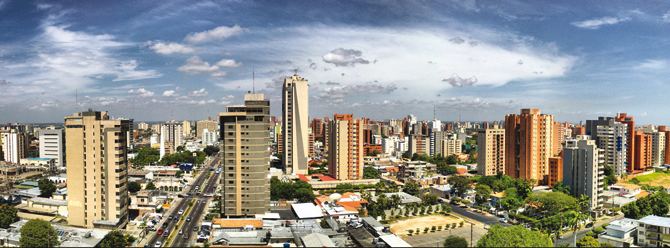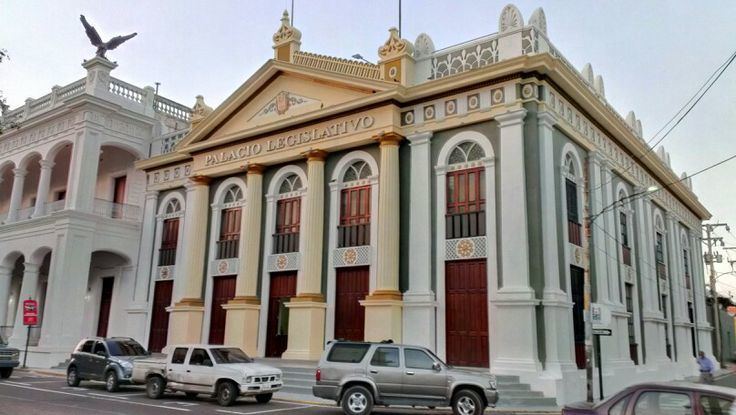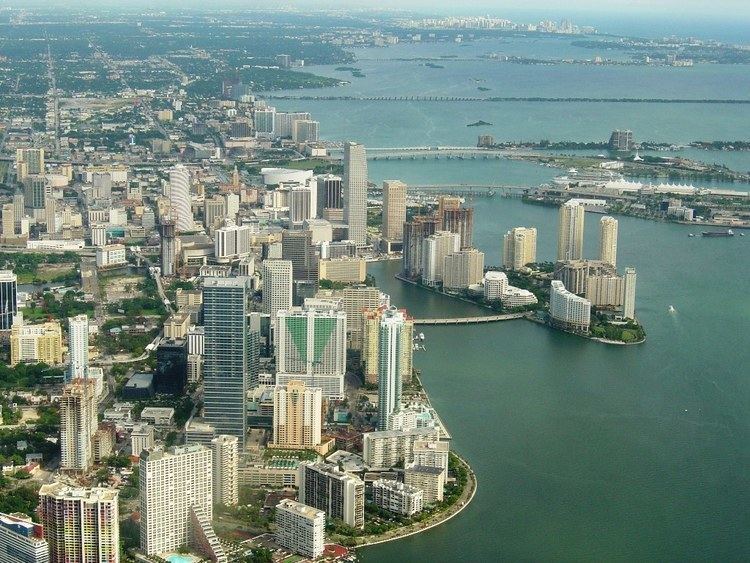Country Area 1,393 km2 | ||
 | ||
Colleges and Universities Dr Rafael Belloso Chacin University, University of Zulia, Universidad Dr Jose Gregorio Hernandez, Universidad Rafael Urdaneta, Universidad Catolica Cecilio Acosta | ||
Founded Ambrosio Alfinger (1529), Captain Alonso Pacheco (1569), Captain Pedro Maldonado (1574) Mayor Evelyn Trejo de Rosales (UNT) | ||
Map of Maracaibo
Maracaibo ([maɾaˈkai̯βo]) is a city and municipality in northwestern Venezuela, on the western shore of the strait that connects Lake Maracaibo to the Gulf of Venezuela. It is the second-largest city in the country (after the national capital Caracas) and is the capital of the state of Zulia. The population of the city is approximately 1,495,200 with the metropolitan area estimated at 2,108,404 as of 2010. Maracaibo is nicknamed La Tierra del Sol Amada ("The Beloved Land of the Sun").
Contents
- Map of Maracaibo
- Espectacular casa quinta maracaibo zona norte beautiful house located best place in maracaibo
- Maracaibo zulia venezuela south america
- Etymology
- Foundation
- Pirates attacks
- Venezuelan independence
- Isolation period
- Building of the bridge
- Modern times
- Perspective
- Economy
- Medicine
- Location
- Climate
- Colleges and universities
- International schools
- Sports
- Culture
- Museums cultural centers and theaters
- Libraries
- Notable natives
- Twin towns Sister cities
- Current food shortage venezuela
- References

Espectacular casa quinta maracaibo zona norte beautiful house located best place in maracaibo
Maracaibo zulia venezuela south america
Etymology

The name Maracaibo is said to come from the brave cacique (Indian chief) Mara, a young native who valiantly resisted the Spaniards and died fighting them. Legend says that when Mara fell, the Indians shouted "Mara kayó!" (Mara fell!), thus originating the city name --although it would be strange for them to shout in Spanish. Other historians say that the first name of this land in the local language was "Maara-iwo" meaning "Place where serpents abound".
Foundation

The first indigenous settlements were of Arawak and Carib origin. Around the main group were the Añu tribe who built rows of stilt houses all over the northern riviera of the Lake Maracaibo. The first Europeans arrived in 1499.

The city was founded three times: the first time was during the Klein-Venedig period (1528–1546), when the Welser bankers of Augsburg received a concession over Venezuela Province from Charles I. of Spain. In August 1529 the German Ambrosius Ehinger made his first expedition to Lake Maracaibo which was bitterly opposed by the indigenous Coquivacoa. After winning a series of bloody battles, he founded the settlement on 8 September 1529. Ehinger named the settlement New Nuremberg (German: Neu-Nürnberg) and the lake after the valiant chieftain Mara of the Coquivacoa, who had died in the fighting. The city was renamed Maracaibo after the Spanish took possession. The lack of activity in the zone made Nikolaus Federmann evacuate the village in 1535 and move its population to Santa Marta near the then capital of Venezuela Province, Santa Ana de Coro.
A second attempt by Captain Alonso Pacheco in 1569 suffered a brief setback when the city had to be evacuated in 1573 due to ferocious attacks by native local tribes. The European settlement returned a short while later in 1574, however, for which it was re-founded by Captain Pedro Maldonado under Governor Diego de Mazariegos' command and assuming the name of Nueva Zamora de Maracaibo. "Nueva Zamora" comes from Mazariego's place of birth, Zamora, in Spain. Since its definite foundation, the town began to develop as a whole. It is based on the western side of Lake Maracaibo, the dominant feature of the oil-rich Maracaibo Basin. Favoured by prevailing winds and a protected harbour, the city is located on the shores of the lake where the narrows, which eventually lead to the Gulf of Venezuela, first become pronounced.
Pirates' attacks
The Dutch corsair Enrique de Gerard plundered Maracaibo in 1614, and in 1642 the city was attacked by the British pirate William Jackson. In 1667, l'Olonnais with a fleet of eight ships and a crew of six hundred pirates sacked Maracaibo and Gibraltar. En route, l'Olonnais crossed paths with a Spanish treasure ship, which he captured, along with its rich cargo of cacao, gemstones and more than 260,000 pieces of eight.
In March 1669, Henry Morgan sacked Maracaibo, which emptied when his fleet was first spied, and moved on to the Spanish settlement of Gibraltar on the inside of Lake Maracaibo in search of more treasure. A few weeks later, when he attempted to sail out of the lake, Morgan found an occupied fort blocking the inlet to the Caribbean, along with three Spanish ships. These were the Magdalena, the San Luis, and the Soledad. He destroyed the Magdalena and burned the San Luis by sending a dummy ship full of gunpowder to explode near them, after which the crew of the Soledad surrendered. By faking a landward attack on the fort, thereby convincing the Spanish governor to shift his cannon, he eluded their guns and escaped.
In June 1678, Michel de Grammont French commander of six ships and 700 men captured Maracaibo then followed the plundering of several smaller towns as Gibraltar, penetrating as far inland as Trujillo.
Venezuelan independence
In 1810, the province of Maracaibo did not join the First Republic of Venezuela and remained loyal to the Spanish crown. Maracaibo then held the seat of the Captaincy General of Venezuela.
In 1821, uprisings in favour of independence began to lead to warfare and hostility. The royalists, led by Francisco Tomás Morales, fought with the patriots, led by Rafael Urdaneta, to take back control over the province in the Juana de Ávila Battle and Morales brought back Spanish rule in 1822 until he was defeated at the Battle of Lake Maracaibo on 24 July 1823, culminating Venezuela's struggle for independence.
Isolation period
For about 390 years, Maracaibo remained isolated and separated from the rest of the country. Transportation was only possible across the lake by ferry or other marine transport.
Cars, buses, and lorries, with their constant flow of manufactured goods and agricultural product, depended on the ferry system between the city and the eastern shore with their roads to connect to the country's motorway system. Maracaibo and the Lake Maracaibo region's economy was more linked to Colombia than to eastern Venezuela due to the natural route available through Lake Maracaibo then leading to the sea.
This isolation was both a challenge and an advantage. The very nature of the city's location made for a population known for their independent thought and character. The history of this region is rife with stories about the creation of an independent and sovereign nation apart from Venezuela, a nation called La República Independiente del Zulia, which means The Independent Republic of Zulia, but this has never come to be.
In January 1903, as the naval blockade of Venezuela continued during the negotiations with presidente Cipriano Castro, the German warship SMS Panther attempted to enter the lake of Maracaibo, a centre of German commercial activity. On 17 January it exchanged fire with the settlement of Fort San Carlos, but withdrew after half an hour, as shallow waters prevented it getting close enough to the fort to be effective. The Venezuelans claimed this as a victory, and in response the German commander sent the SMS Vineta, with heavier weapons, to set an example. On 21 January the SMS Vineta bombarded the fort, setting fire to it and destroying it, with the death of 25 civilians in the nearby town.
In 1908 the Friesland, Gelderland and Jacob van Heemskerck where send to patrol the Venezuelan coast during the second Castro crisis. Friesland guarded the entry way to Maracaibo.
Building of the bridge
The dictatorial regime of General Marcos Pérez Jiménez in the 1950s set as a goal the construction of a bridge connecting the two lake shores. Various bridge projects for the spanning of the Lake Maracaibo narrows near the city were in the works. The general's government had decided that this "city of independent thought" should be more "connected" to the rest of the country.
Proposals for a bridge design that included rail transport and tourist facilities were seriously considered. The fall of the Pérez Jiménez government on January 23, 1958, quickly led to a less elaborate design project that was approved and funded by a democratic and more conservative government.
The building of "El Puente Sobre El Lago de Maracaibo "General Rafael Urdaneta"—(General Rafael Urdaneta Bridge over Lake Maracaibo) named after the distinguished General hero of the War of Independence was opened to public traffic in 1962. The project was completed on schedule in 40 months.
This bridge construction project was a remarkable feat. Built under very difficult conditions, when completed, it became the longest prestressed concrete bridge in the world. The structure is in constant use and remains today as the most important link between Maracaibo, along with much of the state of Zulia, and the rest of Venezuela.
Modern times
Maracaibo has become a large metropolitan city, comprising two municipalities: to the north the municipality of Maracaibo and to the south the San Francisco municipality (established in 1995). In recent years, due to political/economic and cultural reasons, many have moved to Maracaibo from rural areas and other cities (including Caracas).
In the political arena, the citizens of Maracaibo (and most other cities and municipalities in Zulia state) have in recent years voted for a competitive political system in where the governor is from a certain political party and the mayor or mayors are from the opposite political party. This system has brought many good things to the city and the state; for example, if the governor builds a bridge, one of the mayors will build two, if a mayor cleans a public park, the governor retaliates by cleaning and remodelling another one.
Maracaibo also boasts one of the best universities in the country, the state university. La Universidad del Zulia (LUZ) is well renowned for its excellent law, medical and engineering schools as many other disciplines. Other universities and schools include Universidad Dr. Rafael Belloso Chacín (URBE) and Universidad Rafael Urdaneta, with one of the country's leading psychology schools.
The Diocese of Maracaibo (23 July 1965) was elevated to Archdiocese on 30 April 1966 by Pope Paulus VI. Maracaibo was visited by Pope John Paul II in 1985. Since November 2000, its Archbishop has been Ubaldo Ramón Santana Sequera.
Perspective
François de Pons, an agent to the French government in Caracas, provides some historical insight into the people of Maracaibo in his travel journal (de Pons 1806). The following excerpts describe the local population of Maracaibo:
They perform coasting, or long voyages, with equal facility; and when all trade is suspended by the operations of war, they enter privateers. Bred up in the neighbourhood of the lake, they are mostly all expert swimmers and excellent divers. Their reputation stands equally high as soldiers. Those who do not enter into the sea service, form plantations, or assist in cultivating those that belong to their fathers. Nothing proves better their aptitude for this kind of occupation, than the immense flocks of cattle with which the savannas of Maracaybo [sic] are covered.He also notes the appreciation of literature, the arts, education, and culture among the people of Maracaibo:
But what confers the greatest honour on the inhabitants of Maracaibo, is their application to literature; in which, notwithstanding the wretched state of public education, they make considerable progress....They likewise acquired the art of elocution, and of writing their mother tongue with the greatest purity; in a word, they possessed all the qualities that characterise men of letters.During the period of de Pons' visit, however, he believed the men of Maracaibo to lack integrity with regard to honouring their commitments:
After allowing that the inhabitants of this city possess activity, genius, and courage, we have nothing further to say in their praise. They are accused of violating their promises, and even of attempting to break through written engagements. Their character, in this respect, is so notorious, that every stranger whom business induces to visit Maracaybo, affirms, that it would be much better to enter into commercial speculations with the women, because they appear themselves to possess that sincerity and good sense that are every where else considered as belonging particularly to men.Economy
Zulia´s main income comes by the oil extract and refinery, Agriculture: Coffee, rice, maize, cassava, cocoa, sugar cane. Production livestock and Mining: Clay, limestone, coal and sand
Medicine
Huntington's disease prevalence worldwide is 5–10 cases per 100,000 persons. One of the highest incidences is in the isolated populations of the Lake Maracaibo region of Venezuela, where HD affects up to 700 per 100,000 persons.
Location
The Maracaibo Municipality is currently divided into 18 parishes, which are
Climate
Maracaibo is one of the hottest cities of Venezuela. The rain shadow of the Sierra Nevada de Santa Marta gives the city a semiarid climate (Köppen: BSh) only attenuated by the moderating influence of the lake; its average historical temperature is 29 °C (84 °F). In the past the climate of the city, as well in all the coast of the Lake Maracaibo, was unhealthy, due to the combination of high temperatures with high humidity. At the present time, the effects of urban development, and control of plagues, has almost eradicated that. The registered high temperature of the city is 41 °C (106 °F), and the lowest is 18 °C (64 °F).
Colleges and universities
Several universities are based in the city:
International schools
Sports
Due to the regionalistic nature of Marabinos, they strongly support their native teams. Maracaibo, and the rest of Zulia, are represented in baseball by the Águilas del Zulia, a Venezuelan winter league team that plays in the Liga Venezolana de Béisbol Profesional, and is based in the Estadio Luis Aparicio El Grande. The city's basketball team is Gaiteros del Zulia, which plays in the Liga Profesional de Baloncesto de Venezuela. Its home is the 5.000-people Pedro Elías Belisario Aponte stadium. Other teams include the Unión Atlético Maracaibo and the Zulia FC in football, the Maracaibo Rugby Football Club and the Zulianos Rugby Club.
In the 2000 Little League World Series, the Sierrra Maestra Little League of Maracaibo, Venezuela defeated Bellaire Little League of Bellaire, Texas in the championship game of the 54th Little League World Series. The Coquivocoa Little League team from Maracaibo placed third in the 1974 Little League World Series.
Rugby in Venezuela was first played in Maracaibo, thanks to the influence of the English community based on the Zulia Estate
Team:
Culture
Culture in Maracaibo is very indigenous and unique, is recognized in every state and city in Venezuela, and is very influential with its gaitas, desserts, style, living, and customs. Most major houses of advertising in Venezuela acknowledge how opposite the culture of Maracaibo is from that of Caracas. Studies of both prove, for example, that Caracas' leading soft drink brand is Coke, while in Maracaibo it is Pepsi. This has made many brands create special localised advertising of their products (including several Pepsi commercials spoken by local celebrities).
Marabinos are extremely proud of their city, their culture, and all of Zulia. They usually claim that Venezuela wouldn't be the country it actually is without Zulia. Rivalry with inhabitants of other regions is common, specially with Gochos (people of the Trujillo, Mérida and Táchira state) and Caraqueños (people of the city of Caracas).
The Gaita is a style of Venezuelan folk music from Maracaibo. According to Joan Corominas, it may come from gaits, the Gothic word for "goat", which is the skin generally used for the membrane of the furro instrument. Other instruments used in gaita include maracas, cuatro, charrasca and tambora (Venezuelan drum). Song themes range from humorous and love songs to protest songs.The style became popular throughout Venezuela in the 1960s, and it fused with other styles such as salsa and merengue in the 1970s. Famous gaita groups include Maracaibo 15, Gran Coquivacoa, Barrio Obrero, Cardenales del Éxito, Koquimba, Melody Gaita, Guaco, Estrellas del Zulia, Saladillo, and many others.
Museums, cultural centers and theaters
Libraries
Notable natives
Twin towns – Sister cities
Maracaibo is twinned with:
